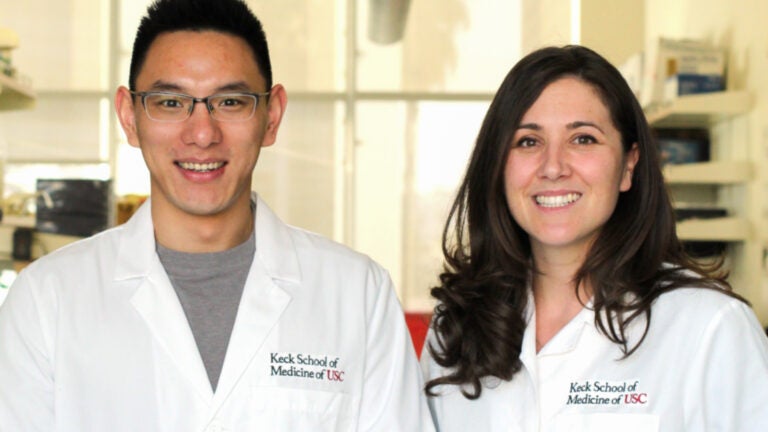
Graduate student Haoze (Vincent) Yu and postdoctoral fellow Kate Galloway (Photo/Cristy Lytal)
USC scientists in different labs take on a neurodegenerative disease
Haoze (Vincent) Yu and Kate Galloway receive grants for a collaborative project that demonstrates their creativity and independence
This year’s Doerr Stem Cell Challenge Grant brings together two young scientists from different USC labs to tackle the fatal neurodegenerative disease ALS.
“These $10,000 grants make it possible for our students and postdocs to connect and collaborate on one-year interdisciplinary projects spanning different labs,” said Andy McMahon, chair of the executive committee of USC Stem Cell. “The students and postdocs initiate and propose the projects themselves — thus developing their creativity and independence.”
The winning project was conceived on a typical Friday in the seminar room of the Eli and Edythe Broad Center for Regenerative Medicine and Stem Cell Research at USC. Haoze (Vincent) Yu, a graduate student studying hearing loss in Neil Segil’s Lab, was delivering a talk about his latest discovery: a new technique for identifying gene regulatory regions. A lightbulb went off for Kate Galloway, a postdoctoral fellow in Justin Ichida’s Lab who studies motor neurons derived from ALS patients.
Even though Galloway and Yu study two different organ systems in two different labs, they are now working together. Their collaborative project will tackle a fundamental mystery surrounding ALS: Although scientists have identified gene mutations that can cause ALS, more than 80 percent of patients with the disease do not actually have these known mutations. This suggests that something else underlies the disease — such as a problem not with the genes themselves, but with the section of the genome that regulates the genes.
Previously, studying gene regulatory regions required large numbers of cells. However, motor neurons, the cells that degenerate in ALS, are not easy to obtain. Harvesting motor neurons, which communicate critical signals from the brain to the muscles, would inflict serious damage on patients. Alternatively, while Galloway and her colleagues in the Ichida lab can reprogram easier-to-obtain skin cells from patients into motor neurons, they can only make small numbers of cells.
However, these small numbers of motor neurons are now sufficient for identifying and analyzing their gene regulatory regions, thanks to Yu’s game-changing new technique.
“The technique that Vincent has developed for the analysis of small numbers of cells, when fully developed, will be a powerful tool for many fields that face similar problems,” said Segil, professor of research in the Department of Stem Cell Biology and Regenerative Medicine and in the USC Tina and Rick Caruso Department of Otolaryngology—Head and Neck Surgery. “The idea to investigate the gene regulatory networks in developing motor neurons addresses a fundamental hole in the field, and seems a great place for them to join forces.”
Future plans
In the future, Galloway and Yu would like to compare the gene regulatory networks of two types of lab-created motor neurons: those derived from ALS patients and those derived from healthy individuals. By identifying differences in the way that ALS patients regulate their genes, they may discover new targets for therapeutic drugs to treat the disease.
“I’d like to thank the Doerrs for supporting this exciting collaborative research,” Yu said.
“Vincent’s innovative ATM-ChIPseq method will be transformative for understanding motor neuron biology,” Galloway added. “Finally, we will illuminate the fundamental regulatory programs unique to motor neurons and extend our search for the molecular dysfunctions that cause ALS.”
